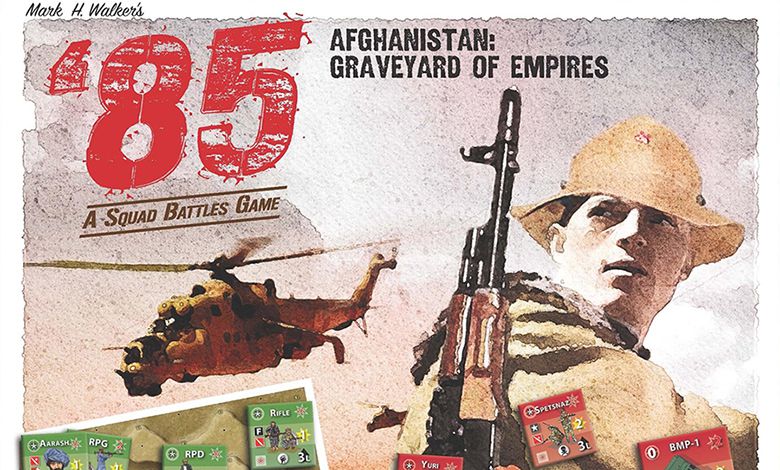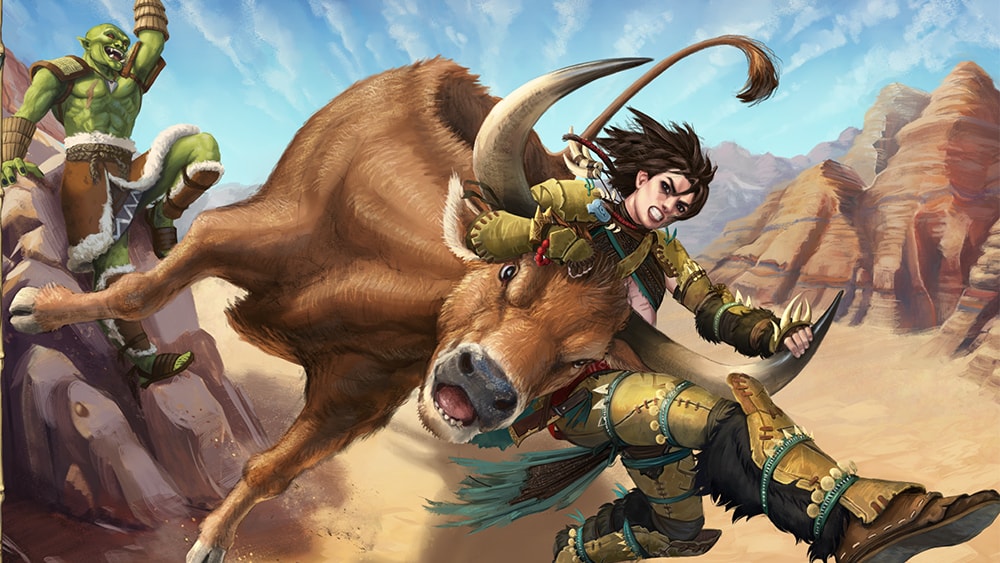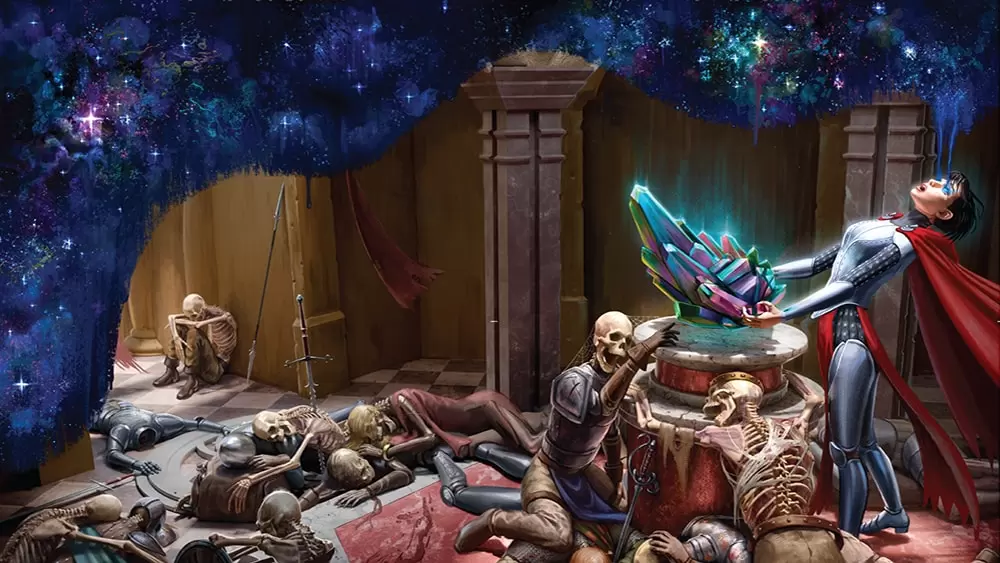Please note this article originally appeared in Line of Fire Magazine Issue #7 and is authored by Pete Abrams. Heroes of the Gap is currently listed for preorder on the Lock n’ Load P500.
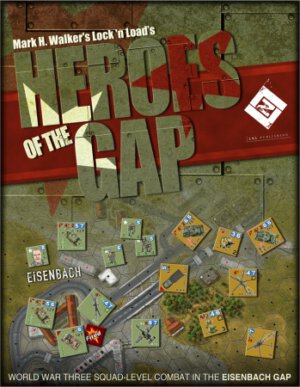
Lock ‘n Load Re-imagines the Cold War in Heroes of the Gap
By Pete Abrams
Let’s face it, there are a lot of us war-gamers who yearn for the good ole’ days of the Cold War. Back then there was a clear good guy and a clear bad guy in the world, and it all made more sense. After the fall of the Berlin Wall many of us still wondered, What would have happened if the “balloon went up” during the 1980’s and the Warsaw Pact attacked NATO or the bad guy attacked the good guy (depending on what side of the curtain you where on)?
With the upcoming release of Heroes of the Gap, the Lock ‘n Load system will jump back into the hypothetical battlefields of West Germany in 1985. Heroes of the Gap is a complete, stand-alone game that gives all of us gamers nostalgic for the Cold War the fix we need, pitting the Warsaw Pact against NATO forces of old. Set in the Eisenbach Gap of World at War fame, Heroes of the Gap is an intense, fast-paced game that hopes to replicate what would have been the battlefield chaos of the opening days of World War III.
A Day of Heroes (Mogadishu, 1993) featured the proven Lock ‘n Load system could portray modern combat, but the game dealt overwhelmingly with infantry in an urban setting—with a few helicopters and Humvees too. The upcoming release of A Ring of Hills (Falklands War, 1982) also explores modern combat and weapons in detail, but uses few vehicles; it does, however, introduce fixed-wing aircraft to the system. Heroes of the Gap brings all of this and more to the gaming table near you. It will have ATGM’s, modern strike aircraft, DPICM, thermal-imaging sights (just like ARoH) but for the first time advanced modern fire-control systems and dedicated anti-tank helicopters will be used.
Modern Fire-control Systems in Heroes of the Gap
With advanced fire-control systems, all of the vehicles in Heroes of the Gap can move and fire in any of the following combinations during the same impulse (with the exception of vehicles firing ATGM’s):
- Fire and then move
- Move and then fire
- Move, fire and move
- Move and be eligible for Opportunity Fire
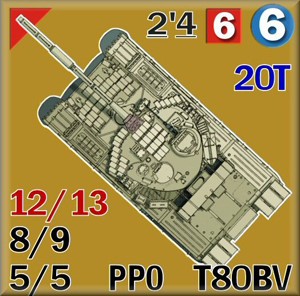
In Heroes of the Gap, players will control an awesome array of weapons, which will include the state-of-the-art systems for their day, and some not-so-state-of-the-art weapons that just happened to be massed produced and expendable. The US player will rely on high-tech weapon systems to thwart a massive Soviet thrust, in which the Soviet’s will attempt to overrun and exploit through superior numbers. You know the whole quantity-has-quality-of-its-own thing. This was always the Soviet plan, and this plan will be tested to the limits in Heroes of the Gap. So will the plans of the vastly outnumbered US forces.
Now let’s talk about some of the hardware Heroes of the Gap. The US player will command the mighty M1 Abrams, later battle proven and nearly invincible, this tank was the peak of battlefield technology in 1985. Even though the M1 will prove a difficult foe for the Soviet’s, Ivan will have strength in numbers and a few tricks up his sleeve. The Soviet’s will have hoards of T-80s, as many as 18 in a single scenario and all with reactive armor, to defeat ATGMs. Tanks and tankers will prove to be the decisive arm of any attack or defense, so let’s start by taking a good look at the tanks of Heroes of the Gap.
Main Battle Tanks (MBTs)
M1 Abrams
Introduced to the US arsenal in 1982, the 54.5 ton M1Abrams was a radical departure from previous US tank designs. Armed with a hard hitting M68E1 105mm rifled cannon and sporting a 1500 horsepower gas turbine engine under the hood, the mighty M1 is the most powerful tank to ever roll onto the Lock ‘n Load battlefield. With a speed of 19T and advanced armor rated of 16 across the frontal arc, the M1 is fast and very hard to kill. Advanced fire control and thermal imaging (TIS) make it extremely accurate, even on the move. The M1 has a penetration of 14 out to a range of 20 hexes and a base hit number of 11. Lock n’ Load has never scene this kind of firepower or accuracy. The M1 can dispatch even the tough T-80 with regularity out to 2000 meters!
Example: An open, assault moving M1 fires at the frontal arc of a stationary T-80 in clear terrain at a range of 20 hexes. The base to hit number is 11 and the OFT DRMs are +1 for AM, -1 for open and +1 for the size of the T-80. The final result is a to hit of 11 with a +1 OFT DRM, an amazing 92 % chance of a hit! The US player rolls a 4 striking the T-80 in the turret. The M1’s penetration at 20 hexes is 14 plus 1d6 and the T-80’s turret front armor is 13 plus 1d6. Check with Mark for %.
T-80
First produced in the late 1970’s, the 43 ton T-80 was the best Soviet tank design of its era. A low and sleek design, the T-80 sports powerful 125mm 2A46 smoothbore cannon with an autoloader. A screaming fast machine moving at 20T (as fast as an M-18 Hellcat) and packing a punch, no M1 will want to get into a knife fight with this tank. Within 1,000 meters a T-80 has a fair chance at taking out an M1 frontally and flank hits from the massive 125 mm will almost always kill an M1.
Example: A stationary, open T-80 fires at the frontal arc of a stationary M1 in clear terrain at 14 hexes. The to-hit number for the T-80 is 9 with a -1 OFT DRM for open, a 91% chance of a hit. The Soviet player rolls an 8, striking the M1’s turret. The T-80’s penetration value at 14 hexes is 13 plus 1d6 and the M1’s turret front armor is 16 plus 1d6. Check with Mark for %.
On defense, the T-80 gets the small target bonus of a +1 OFT DRM and the additional protection of ERA armor across its frontal arc. The ERA will allow the T-80 to shrug of most ITOW attacks and certainly Dragons. The T-80 can also launch the long range Songster ATGM.
T-64
Introduced in the late 1960’s, this 38 ton tank is a tad slower than the T-80 (18T) but nearly identical in games terms. The T-64 has the same 125mm cannon and fire controls as the T-80, sports ERA and can also fire the Songster ATGM. Some 5,000 T-64’s were produced but were never exported, so you will only see a few in the game.
Soviet commanders don’t get too exited about firing those valuable Songsters at the M1; they will be half as effective. See the M1’s armor is in red, meaning that shape charged weapons are halved when attacking (14.2).
Example: The Songster has a penetration value 16. When striking the front turret or hull of an M1 the Songster’s penetration is divided by 2, resulting in a meager 8 penetration. Not enough to kill an M1, so save those Songster’s for long range kills against lesser targets.
T-72
The ubiquitous T-72 is a cheaper more conservative, massed produced cousin to the T-80 and T-64. It has a less effective fire control system and a speed of 16T. Unable to fire the Songster, these tanks also lack the additional protection of ERA, making them a prime target for ATGM’s. Still, if a T-72 can close within 750 meters of an M1, there is a good chance of a kill. Better yet if a T-72 can get a flank shot on an M1 the chances of a kill are greatly increased. Over 15,000 of these tanks were produced and exported.
Example: A stationary closed T-72 fires at the flank of a moving M1 at 15 hexes in clear terrain. The to-hit number for the T-72 is 9 with a +1 OFT DRM for firing at a moving target, a 72% chance of a hit. The Soviet player rolls a 6, striking the M1 on the turret flank. The T-72’s penetration value at 15 hexes is 13 plus 1d6 and the M1’s turret flank armor is 10 plus 1d6. Check with Mark for %.
Infantry Fighting Vehicles (IFVs)
The modern IFV makes its debut in Heroes of the Gap. Both the US and Soviet player will have a mix of IFVs at their disposal. These vehicles combine smaller caliber cannons ranging from 25 mm to 73 mm, with an ATGM to defend against MBT’s. These are deadly machines that can kill a tank and also chew up infantry and APC’s with direct fire. Some IFV’s have smaller caliber cannons with a high rate of fire, that can fire twice per impulse, like the Bradley and BMP-2. However, IFV’s are vulnerable to all but small arms and some small cannons and were never meant to slug it out one on one with tanks on the battlefield.
M2 Bradley
The venerable Bradley makes its debut and combines excellent mobility (18T) and deadly firepower. For the first time, AFV’s in Lock ‘n Load will have both cannon’s and ATGM’s. The back of the Bradley counter contains the range, to hit and penetration for both the 25mm Bushmaster cannon and ITOW in simple and easy to read format. The Bradley also has advanced spaced laminate armor, which offers greater protection from light anti tank weapons but the M2 can only carry a meager 6 troops. The ITOW will destroy most any AFV except for those Soviet tanks with ERA and the 25mm Bushmaster cannon will knock out most APC’s and IFV’s out to 1,000 meters. The Bradley also has the added benefit of TIS and advanced fire control.
Example: A stationary, open M2 fires its cannon at the frontal arc of a moving BMP-2 in light woods at 18 hexes. The to hit number for the M2 is 9 with a +1 OFT DRM for a moving target, +1 for light woods, +1 for target size and a -1 for open, a 58% chance. The US player rolls an 8 and adds the +2 OFT DRM, a miss. But wait, the 25 mm Bushmaster has a rate of fire of 2. The US player can fire again with a 58% chance of a hit. The US player rolls again and this scores a hit with a roll of 7, striking the BMP on the hull front. The M2’s penetration at 18 hexes is 3 plus 1d6 and the BMP-2’s hull armor is 2 plus 1d6.
BMP-1
Introduced in 1967, the BMP-1 was the world’s first true Infantry Fighting Vehicle to combine both cannon and ATGM. Armed with a low pressure 73mm SP-9 gun and AT-3 Sagger ATGM, the BMP-1 also carries 9 troops. The BMP-1 suffers from many shortfalls like a 1 man turret, inaccurate 73mm cannon and only one Sagger was mounted and ready to fire. The remaining stowed Sagger’s had to be loaded, externally onto a rail mounted above the 73mm, a dangerous task under fire. Thus the BMP-1 has an ATGM depletion of 5 and so the Sagger should be used sparingly.
Example: A stationary, open BMP-1, in clear terrain announces it will fire a Sagger at an open, moving Bradley in clear terrain at 28 hexes. (ATGM’s can only be fired when stationary and no other weapon on the vehicle can be fired during the impulse. Upon the BMP-1 announcing the firing of the Sagger, the US player can conduct opportunity fire against the BMP-1, with eligible units firing guns or cannon—rule 14.4, ATGMs). The targeted Bradley has not fired and in the interest of self preservation, decides to fire its 25 mm at the BMP-1. The to-hit number for the Bradley is 8 with a +1 OFT DRM for AM, a -1 for open and a +1 for target size, a 58% chance. The US player rolls an 8, a miss but remember that 2 ROF on the 25 mm. The Bradley fires again, this time scoring a turret hit on the BMP-1 with a roll of 6. Regardless of the damage, the BMP-1 fires the Sagger and as 13.94.3 states the missile misses. The Soviet player rolls a 2d6 for depletion purposes and the colored die is a 3 which is less than the depletion number of 5. The BMP-1 is now out of Sagger ammo and is marked accordingly.
BMP-2
The BMP-2 entered service in the mid 1980’s and had many improvements over its predecessor. Armed with a 30mm auto cannon in a new two man turret and an AT-5 Spandrel ATGM, the BMP-2 had a reduced capacity of 7 troops. The 30mm is far more accurate and deadly than the low pressure 73mm cannon of the BMP-1 and like the Bradley has a 2x ROF. The AT-5 ATGM is a more powerful and accurate missile but still has to be reloaded externally.
BMD
Introduced in 1970, the BMD is a scaled down air mobile version of the BMP-1. It has an identical turret and weapons system but a completely different chassis. Lightly armored it carries 6 troops and equips Soviet Air Mobile troops. The BMD can be dropped by parachute or sling loaded under large helicopters.
***
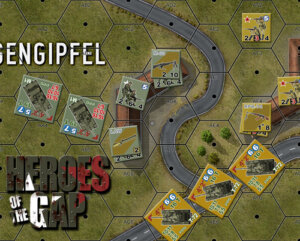
M901
Mounted on a M113 chassis, the M901 has an armored launcher assembly that contains 2 Improved TOW missiles. The launcher is raised to search for targets, fire and track the missiles. Once the two missiles are fired, the launcher is folded back and crewman can load the launcher from the armored troop compartment while under cover. The M901 has two ITOW’s ready to fire and another 10 missiles stored inside the vehicle, thus a lower depletion number of 2.
Example: A stationary, closed M901 announces it will fire an ITOW at the frontal arc of a stationary T-72, in open terrain at a range of 30 hexes. The T-72 is marked with a fired marker and the Soviet player has no other units eligible to fire on the M901. The to hit number for the M901 is 11 with a +1 OFT DRM for the T-72’s size, a 91% chance of a hit. The US player rolls an 8 and adds the +1 OFT DRM, striking the T-72 in the turret. The ITOW has a penetration of 18 plus 1d6 at 30 hexes, and the T-72’s’s turret front armor is 11 plus 1d6.
BRDM AT
Armed with 5 ready to fire, AT-5 Spandrel missiles in tube launchers, the BRDM AT is small, fast (20R) and deadly. While not as sophisticated as the M901, the BRDM AT is a serious long range threat to all enemy AFV’s except the M1. The BRDM AT has another 4 missiles stored inside thus a depletion number of 3.
A variety of wheeled and tracked APC’s will also be found in Heroes of the Gap. Though not as sexy as tanks or IFV’s, these vehicles fill the crucial role of battlefield taxi. Fast and lightly armored, APC’s protect their crews and troops from small arms and shell splinters. The Soviets prefer fast wheeled APC’s like the BTR and the US, the popular M113. Both vehicles have heavy machine guns to defend against infantry, aircraft, lightly armored and soft vehicles. APC’s are great for rushing infantry to the battlefield out of sight of the enemy, however they are easy kills for any weapon larger than a machine gun. Once near the battle you will have to conceal them or risk losing crucial transportation for the slower infantry units.
***
Helicopters have flown about Lock ‘n Load for years but a new generation is about to enter the game, the dedicated ant-tank attack helicopter. In Heroes of the Gap the deadly AH-1 Cobra and Mi-24 Hind appear over tree tops to snipe unsuspecting tanks at extreme ranges. These helicopters also carry rockets and heavy machine guns or cannons for soft targets and lightly armored vehicles. The Cobra and HIND are game changers and when properly employed can stop the enemy cold. Although tougher than previous helicopters they are still vulnerable to ground fire and within the confines of the Heroes of the Gap map must be used with care. Any anti- aircraft missile or dedicated AA vehicle can bring down a chopper with a hit.
AH-1 Cobra
Developed in 1965 the AH-1 Cobra was the world’s first true attack helicopter. In the mid 1970’s the Cobra was upgraded with thermal imaging and armed with ATGM’s to hunt and kill tanks. The Cobra is a fast, agile helicopter with a slim, armored fuselage, making it a difficult target. The Cobra in Heroes of the Gap is configured in the anti tank role and is armed with 8- ITOW missiles with a depletion of 2 and a 20mm cannon. The ITOW is the principal weapon of the Cobra and should be used at long range to pick off enemy tanks. To suppress infantry and knock out lighter vehicle, the 20mm cannon will do the trick.
Mi-24 HIND
Larger, heavier and faster than the Cobra, the Hind is heavily armored and can carry serious weaponry. First observed in 1973 the Soviet’s affectionately call the HIND the
“Flying tank”. The HIND can also carry troops, although it rarely will, preferring to carry extra ammo. The HIND in Heroes of the Gap is armed with a rotary .50 caliber machine gun, rockets and 4-Sagger ATGM’s with a depletion of 4. The HIND is tough with a defense of 4 and also has thermal imaging for targeting at night.
To defend against the attack helicopter players will have a mix of man pack SAM’s and dedicated anti aircraft vehicles. Man pack SAM’s debuted in A Ring of Hill’s but for the first time air units will face specialized AA vehicles. The M163 Vulcan and Shilka are armed with fast firing cannon’s with RADAR guidance and tracking to pulverize air units at close ranges.
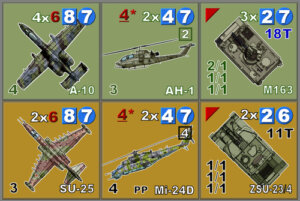
Heroes of the Gap will include a mix of infantry and support weapons to support the armor. Infantry will have the usual array of light anti tank weapons like the LAW and RPG but there will be heavier wire guided ATGM’s to support the infantry like the Soviet Sagger and US Dragon. These missiles pack a more serious punch and have the ability to kill some tanks and all light armored vehicles.
Players will find Heroes of the Gap to be a fast and deadly game. During playtesting it was immediately apparent that weapon accuracy and killing power was exponentially higher than in previous Lock ‘n Load releases. Attrition is high and the burning hulks of tanks and APCs litter up the landscape quickly. Exposed infantry does not have a chance. You have to play smarter and faster than ever before. Almost any unit that can be seen can be hit and killed the first time! It is a game of the quick and dead.







